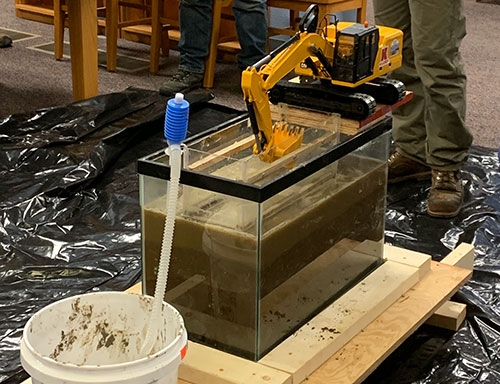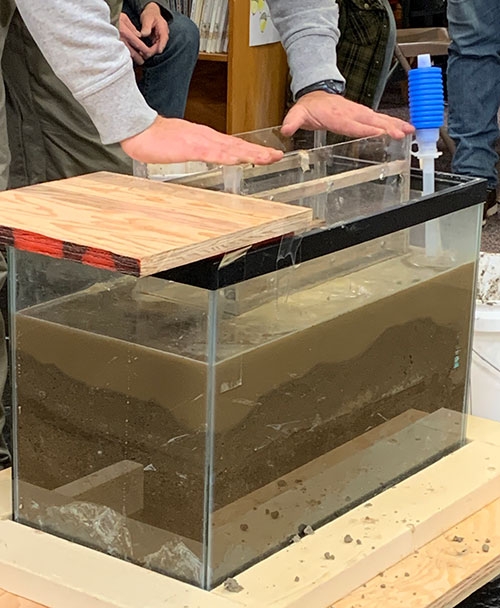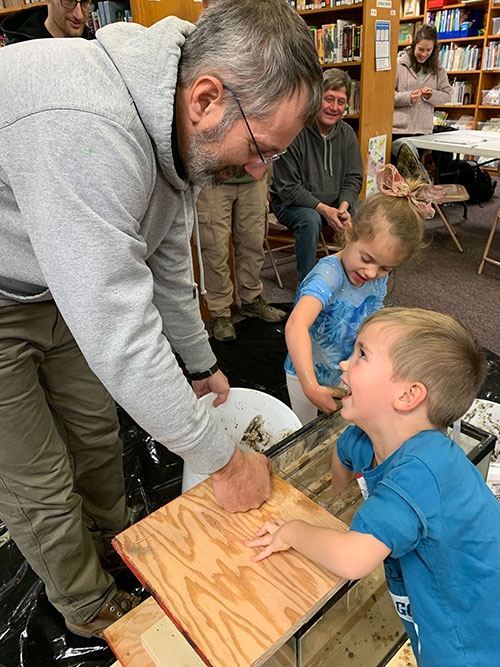You are here
Home ›Third session of “Let’s Talk Bridges!” features a hands-on activity with a “mini cofferdam”

A presentation attendees can really dig into ... The excavator pictured above was used to show how material is dug out of cofferdams at the Thursday, January 11 “Let’s Talk Bridges” program at Meehan Memorial Lansing Public Library. Dale Kehoe, superintendent in charge of the new Lansing bridge construction project job site for contractor Kraemer North America, picked up the excavator at a local store and decorated it with Kraemer’s red K emblem. Kehoe also built the mini cofferdam for the presentation from materials he bought at a local store. Photo by Julie Berg-Raymond.

Simulating the actual work being done ... Travis Konda, a structural engineer and Lansing bridge project manager for HNTB Corporation, pushes a demonstration cofferdam into the water and sand inside a donated fish tank at the Thursday, January 11 “Let’s Talk Bridges” program at Meehan Memorial Lansing Public Library. The demonstration offered an idea about work currently taking place at the new bridge construction site. Photo by Julie Berg-Raymond.

Definitely a hands-on (or in) presentation ... Travis Konda, structural engineer and Lansing bridge project manager for HNTB Corporation, gets some young help digging sand out of a demonstration cofferdam at the Thursday, January 11 “Let’s Talk Bridges” program at Meehan Memorial Lansing Public Library. The presentation simulated the work actually being done at the new bridge project construction site. Photo by Julie Berg-Raymond.
by Julie Berg-Raymond
Even with the town blanketed in the first heavy snowfall of the season, the third monthly session of “Let’s Talk Bridges!” drew about 30 attendees to the Meehan Memorial Lansing Public Library Thursday evening, January 11.
ABOUT THE TALKS: WHO, WHAT, WHEN
The library’s executive director Derva Burke, along with the new Lansing bridge project’s overseeing engineer Clayton Burke and members of his team, are presenting the family-friendly monthly series - which is focused on learning about and celebrating the new bridge project at Lansing. Three of the regular four “bridge talks” team members conducted the talk last Thursday: Clayton Burke was joined by Paul Lindsey, senior field inspector on the project and Travis Konda, a structural engineer and project manager with the U.S.-based design firm, HNTB Corporation. Absent that evening was “everything engineer,” Anden Lovig.
For the first time, the team welcomed two members of Kraemer North America, contractor on the new bridge project, to the evening’s talk - Project Manager Aaron Rosenbery and Field Engineer Brandt Zeeh. Burke also introduced two more team members, not present that night, to attendees - Brian Swestka, an inspector with the Iowa Department of Transportation (DOT), and Jered Gerner, an inspector with HNTB. “Brian likely won’t be available for the events as he drives home quite a ways each night,” Burke said; “but Jered might attend in the future.”
Everyone is invited to attend the talks, which are held at the library on the second Thursday of every month, from 5 to 6 p.m.
VIDEO UPDATES: “WHAT’S BEEN GOING ON …”
Clayton Burke presented the first part of the evening’s session, using videos captured in the field using the software system HeadLight, a tool in construction management. “The videos and pictures are captured by any one of our construction staff and posted to the same project page similar to social media posts,” Burke said in a follow-up email interview. “We have been selecting a few photos from Headlight to use in our public updates on our website and Facebook page each time we create new content.”
The first video Burke showed involved the construction of a drilled shaft. In the video a large vibratory hammer shakes a ten-foot diameter steel casing (“a big hollow steel tube”) into the ground near the bank on the Wisconsin side of the river. “The vibratory hammer weighs almost 100,000 pounds and shakes up and down very quickly to vibrate and push big objects like the steel casing into the ground,” Burke said. “Now that this casing has been driven into the ground over 70 feet deep, the contractor will start digging all of the soil and sand out of the casing so they can fill it with concrete.”
The second video showed the auger used to dig out the casing. “This is essentially a big corkscrew or drill that a crane-operated drill rig twists into the ground and lifts back out full of the soil and sand,” Burke said. “The auger is then moved away from the hole with the crane and spun to fling all of the soil off onto the ground. This is done over and over again to dig the hole for the drilled shaft.”
The third video involved what Burke called a “driving pile,” and showed a piece of machinery called a pile hammer. “It functions like a huge, one-cylinder diesel engine,” he said. “A large piston moves up and down in a cylinder with diesel fuel and oil injected. Each time the fuel ignites, it creates powerful force downward that drives our pile into the ground.” The pile they are using are long, steel tubes with diameters of 14 and 16 inches. “We call these closed-end pipe pile because they have a metal cap on the bottom end to keep the sand and water out,” he said. They drive them deep into the ground until they reach a layer of soil or rock that has the strength they need to support the bridge.
The last video Burke showed was of a welder welding on another section of pipe pile. “To go over 100 feet into the ground, the pipe pile have to be shipped to the construction site in about 50-foot-long pieces,” he said. Burke said the sparks that people have been seeing from the road are from the welding of two of these pieces together after most of the first 50-foot piece has been driven into the ground. “It takes some very skilled operators and welders as the next piece of pile has to be held in the air by a crane while it is being welded together,” he said.
“COFFERDAM CONCEPTS”
During the second part of the night’s presentation, Structural Engineer Travis Konda spoke briefly about cofferdams and about some of the forces that push on their walls. Cofferdams are large metal rectangles built within a body of water to allow the enclosed area to be pumped out or drained. The pumping creates a dry environment so work can be carried out safely.
On the new bridge project, there are currently two cofferdams - for piers 4 and 5 of the bridge. Among the factors built into the cofferdams to make them safe work environments are two routes of escape and an airhorn to sound in case of an emergency. The two escape routes are typically two ladders set up so workers can climb out of the cofferdam.
The walls of the cofferdams are made of corrugated steel sheets - “the corrugation, like in cardboard or plastics, makes the steel sheets very strong and difficult to bend,” Clayton Burke explained in a follow-up email interview. “Right now, the workers are making sure the pipe pile are driven into the ground correctly, and they are welding on the additional pieces. After the pile are complete, they will start tying the metal rebar reinforcing cage and building concrete forms for the reinforced concrete footings that piers 4 and 5 will sit on.”
HANDS-ON DEMO: A MINI COFFERDAM
Closing out the session, Konda conducted a hands-on demonstration with a “mini” cofferdam, using a fish tank filled with sand and water and a small water pump.
“Kraemer went above and beyond, helping us out,” Clayton Burke told attendees prior to the hands-on demonstration that evening. “We shared our plan to construct a cofferdam demonstration at our project progress meeting with Kraemer; and Kraemer - particularly Dale Kehoe, Kraemer’s superintendent in charge of the job site - took a personal interest in helping us build the demonstration.”
Burke said Kehoe helped with everything from purchasing the plexiglass and building the cofferdam and the wooden carrying platform for the fish tank, to providing the toy excavator. “He picked up (the excavator) at a local store and decorated it with Kraemer’s red K emblem,” Clayton Burke said. “Some would say he had way too much fun with it.”
Attendees had fun with it, as well. After Konda filled the fish tank with sand and then with water, he pushed the plexiglass cofferdam into the tank. Konda and two young helpers then went to work digging out sand - first they dug with their hands, but they fairly quickly moved on to using the excavator - and then pumping out water from the cofferdam.
“It was fascinating to see it all come together,” Burke said. “We don’t know who, but someone from the community donated the fish tank. It was a big group effort to put together such a cool demonstration, and it set the bar high for the next event in February.”
The next session of “Let’s Talk Bridges!” is scheduled for Thursday, February 8, from 5 to 6 p.m., at the Meehan Memorial Lansing Public Library.
For more information about the bridge project and to sign up to receive project updates via email, visit the website for the project at iowadot.gov/lansingbridge/Home. The project’s Facebook page can be reached at https://www.facebook.com/LansingBridge/.

